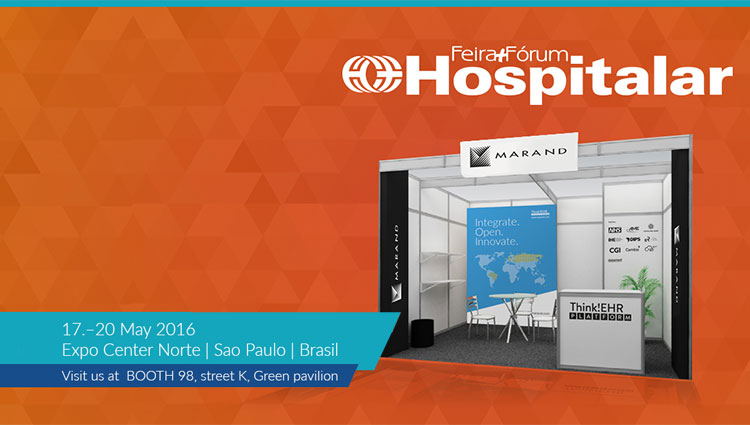Postmodern EHR
See the following -
OSEHRA 2016: Marand to present on Postmodern EHRs at Open Source Summit
 Tomaž Gornik, CEO of Marand, will speak at OSEHRA Open Source Summit in Washington DC, the largest annual event in open source health-technologies in the USA. Openness and agility are at the core of Postmodern EHRs. The term “Postmodern” was launched recently by Gartner when describing the ongoing evolution of ERP systems moving from monolithic towards modular systems. Tomaž Gornik applied this concept to EHRs in a series of blog posts and recent presentations at different events around the globe (see blog posts, list of events).
Tomaž Gornik, CEO of Marand, will speak at OSEHRA Open Source Summit in Washington DC, the largest annual event in open source health-technologies in the USA. Openness and agility are at the core of Postmodern EHRs. The term “Postmodern” was launched recently by Gartner when describing the ongoing evolution of ERP systems moving from monolithic towards modular systems. Tomaž Gornik applied this concept to EHRs in a series of blog posts and recent presentations at different events around the globe (see blog posts, list of events).
- Login to post comments
The Postmodern EHR: What are the Enablers?
 Traditional monolithic EHR architectures focus on stability and standardization at the expense of agility. Along with innovation, cloud based deployment and integration of things, agility is the main differentiator when describing the requirements of application architecture for the Postmodern EHR. Achieving agility is impossible for the vast majority of healthcare applications today as they are an inseparable mix of code for user interface, decision logic, workflows and data definitions. New architectures promote agility and reuse by turning the applications inside out and layering the four types of programming into portals, rule engines, process engines and XML data. Let’s look at some examples, layer by layer:
Traditional monolithic EHR architectures focus on stability and standardization at the expense of agility. Along with innovation, cloud based deployment and integration of things, agility is the main differentiator when describing the requirements of application architecture for the Postmodern EHR. Achieving agility is impossible for the vast majority of healthcare applications today as they are an inseparable mix of code for user interface, decision logic, workflows and data definitions. New architectures promote agility and reuse by turning the applications inside out and layering the four types of programming into portals, rule engines, process engines and XML data. Let’s look at some examples, layer by layer:
- Login to post comments
The Postmodern EHR: The Data Layer
 This second approach entails defining a data layer, which is the most important aspect of the Postmodern EHR architecture from my previous post. Why is this the most important layer? Most healthcare organizations are beginning to realize that their data is more valuable than their applications. Data has become a key asset, since good data is key to improving outcomes, managing chronic disease and enabling population health management. And it needs to be managed for the lifetime of the patient. Which application is going to last that long? What happens to health data when we switch applications?
This second approach entails defining a data layer, which is the most important aspect of the Postmodern EHR architecture from my previous post. Why is this the most important layer? Most healthcare organizations are beginning to realize that their data is more valuable than their applications. Data has become a key asset, since good data is key to improving outcomes, managing chronic disease and enabling population health management. And it needs to be managed for the lifetime of the patient. Which application is going to last that long? What happens to health data when we switch applications?
- Login to post comments
The Postmodern EHR: What can Health IT Learn from the Evolution of the ERP Market?
 It seems the pattern is clear. From best of breed to integrated (mega)suite to a new world of innovative, agile, mostly cloud based and multivendor solutions. This is what Gartner calls “Postmodern”. According to Christensen, disruption like this becomes possible when the established players start exceeding the requirements and expectations of their customers, providing only sustaining innovation – i.e. adding more and more features to their products. This is what was happening in the personal productivity space with the Office products. Similarly, the ERP market today has well defined requirements and this allows the newcomers to disrupt, meeting the base expectations and adding innovation and agility while lowering costs.
It seems the pattern is clear. From best of breed to integrated (mega)suite to a new world of innovative, agile, mostly cloud based and multivendor solutions. This is what Gartner calls “Postmodern”. According to Christensen, disruption like this becomes possible when the established players start exceeding the requirements and expectations of their customers, providing only sustaining innovation – i.e. adding more and more features to their products. This is what was happening in the personal productivity space with the Office products. Similarly, the ERP market today has well defined requirements and this allows the newcomers to disrupt, meeting the base expectations and adding innovation and agility while lowering costs.
- Login to post comments
Think!EHR Platform Showcased at Hospitalar, One of the Largest Medical and Hospital Exhibitions in South America
 Marand will be showcasing its leading Think!EHR PlatformTM at the Booth Rua K / 98. Meet us there to find out how our “Integrate. Open. Innovate.” approach is being used to build truly postmodern EHRs in South America, too...With Think!EHR PlatformTM, our clients are capable of creating postmodern EHRs—modular clinical information systems which are open and agile, where they’re free to introduce, renew or replace any apps they might require to support their clinical needs, be it on premise or in the cloud, while at the same time integrating all devices, and connecting patients and doctors in ways unobstructed by rigid and costly architectures of monolithic, closed EHR systems.
Marand will be showcasing its leading Think!EHR PlatformTM at the Booth Rua K / 98. Meet us there to find out how our “Integrate. Open. Innovate.” approach is being used to build truly postmodern EHRs in South America, too...With Think!EHR PlatformTM, our clients are capable of creating postmodern EHRs—modular clinical information systems which are open and agile, where they’re free to introduce, renew or replace any apps they might require to support their clinical needs, be it on premise or in the cloud, while at the same time integrating all devices, and connecting patients and doctors in ways unobstructed by rigid and costly architectures of monolithic, closed EHR systems.
- Login to post comments
OpenEHR Day
Over the past years, openEHR solutions with a multivendor environment built on an open and agile architecture have proven to be a successful approach to managing electronic healthcare records at any scale. There are several use cases with a focus on electronic health records (EHR) and related systems, validating the vendor-neutral data concept, where universal interoperability among all forms of electronic health data is ensured.To discuss these topics and present successful use cases, you are kindly invited to the 2019 openEHR day being organized by the openEHR Foundation in collaboration with Better and other partners. The event will take place on Monday, October 28, 2019, at SkillsMatter London, United Kingdom. Read More »
- Login to post comments